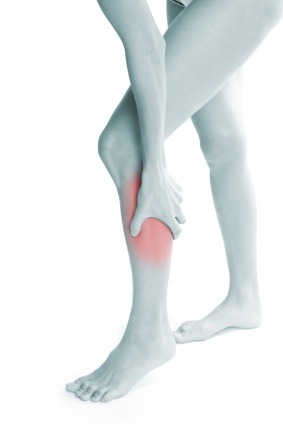Leg cramps, also known as a charley horse, are characterized by sudden pain or tightness in the voluntary muscles of the leg. These muscles are mainly the muscles in the area of the calf, hamstring, or quadriceps, and though the cramp usually only lasts a couple of seconds, it can take several minutes for the muscles to relax. When the muscles relax the pain of the cramp subsides. When discussing leg cramps, it is important to know that there is more than one kind of leg cramp. In fact, there are four categories of leg cramp: true cramps; tetany; contractures; and dystonic cramps. These different types of leg cramps have different possible causes and, therefore, different treatments.
Types of Cramps
True Cramps
These are what most people think of when they hear the word “cramp.” True cramps are the most common and affect muscles that are working together. True cramps may occur following an injury—the muscles cramp around an injured bone to prevent its movement—or vigorous exercise. They may sometimes occur during rest as well. Called night cramps, the cramps that occur at night may wake the sufferer up in the middle of the night.
Tetany
Muscle spasms and cramps that occur due to low levels of calcium and magnesium. These cause a tingly or numb sensation in addition to the painful cramping felt in true cramps.
Contractures
Similar to true cramps, but contractures last longer. During contractures muscles do not relax and nerves are inactive. Decreasing levels of the neurotransmitter adenosine triphosphate, which provides the energy for muscle contraction, contributes to the occurrence of contractures. When there is too little adenosine triphosphate, the muscle stays frozen in a contracted state and cannot relax.
Dystonic Cramps
 Not as common as true cramps, dystonic cramps occur when the muscle not intended to contract, contracts. Dystonic cramps are most often attributed to repetitive motions.
Not as common as true cramps, dystonic cramps occur when the muscle not intended to contract, contracts. Dystonic cramps are most often attributed to repetitive motions.
Leg Cramps? Get Remedies Fast!
Causes of Leg Cramps
Leg cramps are caused by muscles in the leg suddenly and forcefully contracting. Researchers believe this sudden forceful contraction is caused by the hyper excitability of the nerve controlling the muscle. What causes this hyper excitability is unknown. However, there are some things that are contributing factors to leg cramping, even if they do not directly cause the cramping. These contributing factors include:
- Dehydration: Substantial loss of body fluid can lead to muscle contractions.
- Heavy exercising: Heavy activity results in an increased loss of body fluid, thus leading to dehydration and muscle contractions.
- Muscle fatigue: Strenuous activity fatigues muscles, which increases the chance of leg cramping.
- Injury: Torn muscles, shin splints, tendinitis, and stress factors may cause cramping as the body attempts to avoid further injury by cramping the muscles around the injury and decreasing the range of motion of the injured body part.
- Mineral deficiency: Deficiency of calcium, potassium and magnesium can cause over excitability of the nerves of the muscle.
- Poor blood circulation: Associated with leg cramping, and with night leg cramping in particular.
- High weight: Heavier individuals are at greater risk of muscle fatigue and poor blood circulation, which may lead to muscle cramping.
- Medication side effects: Some medications may cause muscle cramping. Side effects of all medication should be discussed with a doctor or pharmacist.
- Position of Feet: Night cramps, in particular, may be influenced by the position the feet are in during sleep. Toes pointing down cause the calf muscle to shorten, thus resulting in cramping if this position is held for too long.
Risk Factors for Leg Cramps
- Age: The risk of experiencing leg cramping increases with age.
- Pregnancy: Pregnant women are at a higher risk of experiencing leg cramping. This may be due to the changes in a pregnant woman’s blood circulation, the stress of the baby on the muscles of the legs, or the pressure of the baby on the nerves and blood vessels.
- Other medical illness: Some illnesses are associated with leg cramping. These illnesses include, but are not limited to: Addison’s disease; alcoholism; cirrhosis of the liver; Type 2 Diabetes; hypothyroidism; Parkinson’s disease; and chronic kidney failure.
Prevention of Leg Cramps
Though leg cramps may not be able to be avoided entirely, there are some methods that help to prevent them from occurring in the first place. These preventative methods include the following:
- Stay hydrated: Muscles need water in order to perform normal activities. When the body is dehydrated, there is an increased risk of muscle cramping. Water is better for hydration than juice or soda, and small amounts should be drunk every thirty minutes to ensure adequate hydration.
- Stretch Regularly: Stretching relaxes muscle fibers, thus reducing the chance of cramps. Warming up and cooling down after exercise is important in leg cramp prevention. If night cramps are a problem, stretching or riding a stationary bike before bed may help.
- Train Gradually: Build up to an exercise regime slowly. Sudden changes in activity result in an increased chance of cramping, as well as the risk of damage to muscles.
- Eat Smart: Mineral deficiencies, such as too little calcium, contribute to leg cramps. Eating a well-balanced, healthy diet and making sure to consume the recommended amount of vitamins and minerals will help to reduce the occurrence of leg cramping, and will promote overall health.
- Walk: When a leg cramps, often the quickest way to get rid of the cramp is to walk it off. Walking stretches the muscles of the leg and helps to alleviate the cramping muscle.
Treatment of Leg Cramps
Although cramping generally goes away on its own, there are some treatments for leg cramping, including at-home remedies as well as over-the-counter and prescription medication. Since leg cramping is such a fleeting ailment, however, many of these treatments are best for those with recurring cramping.
Home Remedies
- Massage: Massaging the sore muscle relieves tension and aids in alleviating the cramp.
- Heat Pad: Applying heat to the cramped muscle can help to relax the muscle and aid in pain management.
- Hot Showers: With the same theory as the heat pad, a hot shower running over the cramped muscle will help to relax the muscle.
- Gentle Stretching: Sometimes simply stretching the cramped muscles or muscles around the cramped muscle can alleviate pan. Flexing the foot, squatting, and other typical stretches of the legs can all help to remedy the leg cramp.
- Chamomile Tea: Drink 5 cups daily for 2 weeks to relieve muscle cramps. The tea contains an amino acid that relaxes muscles.
- Honey: Take 2 teaspoons of honey with meals to prevent recurring foot and leg cramps.
- Mustard or Pickle Juice: Both mustard and pickle juice have acetic acid, which helps produce a stimulant for leg muscles. Take a spoonful of mustard or a few ounces of pickle juice to help prevent leg cramps.
- Apple Cider Vinegar: Mix 1 teaspoon honey and 2 teaspoons apple cider vinegar in a glass of warm water and drink. The apple cider vinegar is high in potassium, which is helpful for the treatment of leg cramps.
- Mustard Tea Bath: Saturate a tub full of warm water with a homemade teabag of brown or black mustard seeds. Submerge legs in the bath for 20 minutes to alleviate muscle cramps.
- Herbal Massage Oil: To be used with massaging cramped muscles. This herbal massage oil is made with one cup of extra-virgin olive oil, with ½ ounce of lobelia, 1 ounce of cramp bark, 1 ¼ ounce of willow bark. Store in a jar for later use, and use to massage into cramped muscles.
Over the Counter Treatments
- Vitamin supplements: Calcium, magnesium, Vitamin B complex, Vitamin C, Vitamin E, and zinc supplements all help to prevent muscle cramps.
- Electrolyte Replacement Beverages: These drinks help to restore electrolytes lost during strenuous activity or exercise. Ensuring proper electrolytes in the blood can help prevent muscle cramps.
Prescription Medications
If leg cramping is a recurrent issue that does not get better using preventative measures, a doctor may issue a prescription medication to help alleviate leg cramping. Prescription muscle relaxers may prevent recurring leg cramping, as well as help relax muscles in the midst of a cramp. Pain medication may be prescribed in order to deal with persistent or recurrent pain caused by cramps. Anti-inflammatory drugs may be prescribed if arthritis or other inflammatory disease is believed to be contributing to leg cramping. Anticoagulants, which are blood thinners, may be prescribed if medical investigation shows a blood clot, which may be contributing to leg cramping.

When to Seek Medical Advice
Though leg cramping is usually a result of unknown causes, it is possible that cramping is indicative of an underlying medical condition, such as diabetes or peripheral artery disease. Therefore, it may be necessary to seek the advice of a medical professional in order to determine if an underlying medical condition is the cause behind frequent cramping. Contacting a medical professional is necessary if self-care does not help to alleviate the cramping, and if cramping is accompanied by: a swollen or red leg; if the cramping is accompanied by a fever; if the pain worsens when walking or exercising and improves with rest; if the leg is bruised; if the leg is cold and pale; or if cramping may be a result of medication side effects.
When visiting a doctor for issues related to leg cramping, the doctor will perform a physical exam, paying special attention to the legs, feet, hips, back, knees and ankles. A complete and accurate medical history will need to be given that includes questions such as: where is the pain; is the pain in one or both legs; is the pain dull and aching or sharp and stabbing; is the pain severe; is the pain worse at any particular time of the day; what makes the pain feel worse; what makes the pain feel better; are there any other symptoms, such as numbness, tingling, back pain, fever, or weakness?
After a physical exam and when the medical history has been completed, some diagnostic tests may be performed to narrow down the cause of the leg cramping. These tests range from x-rays to bone biopsies, and as with any medical procedure, a candid discussion should take place with the doctor regarding the method, side effects, and any concerns surrounding the procedure.
Healthy diet and moderate exercise are required not only to avoid leg cramping, but also to ensure overall good health. Before beginning an exercise regime—and especially if leg cramping is recurrent—it is important to ensure that the planned exercise can be completed safely. It may be necessary to substitute low impact exercise for higher stress exercises if the cause of the leg cramping is an injury or other underlying medical condition.

2 Comments
I am a physician who first began experiencing “charley-horse” cramping of my left leg a month ago. Cramping was recurrent, about every 3 hours every night. Occasionally, they occurred after I had been sitting for an hour or so. Standing, or attempting to walk relieved the cramps after several minutes. I was well hydrated, and my blood electrolytes were normal. An ultrasound exam of my blood vessels was also normal. I tried magnesium/zinc/vitamin E supplements. I drank gallons of Tonic water(quinine). No changes. However, I started taking HYLAND’S Leg Cramps pills two weeks ago. IMMEDIATE SUCCESS!!! I have not had a single cramp since I began taking these easily dissolved tablets. I’m hoping that this very affordable treatment option will continue. P.S.: my energy level has also improved as well.
Hot water bath can also help you to get rid of muscle cramps. Also, add BCAA to your diet for more added benefits of muscle recovery.